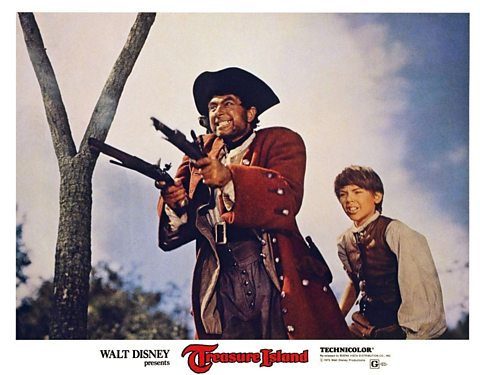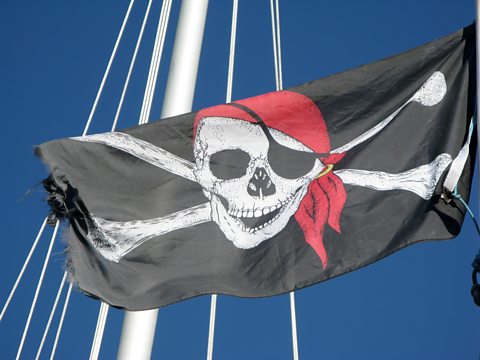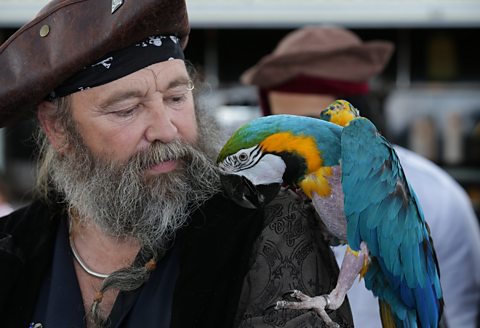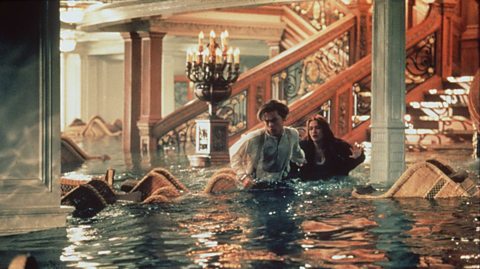Ahoy me hearties! Welcome aboard our quest to sift the fact from the fiction in pirate history.
From parrots to treasure, planks to flags, we’ll see just how much truth there is in the pirate stories we’ve grown up with.
Dr Rebecca Simon, an early modern piracy expert, is on hand to guide us through some of these murky waters.
So let’s weigh anchor and begin…
Pirates had their own special slang
False!
Most of the slang that we associate with pirates actually come from pop culture.
Dr Simon highlights one film in particular as the culprit, based on the book by Robert Louis Stevenson: “Robert Newton, who played Long John Silver in the 1950 adaptation of Treasure Island, gave us many popular pirate phrases.
“His pirate accent was a very exaggerated version of his own accent (southwest England/Cornwall) and created the arrrrrr as a character signature. He also used phrases he picked up from sailing communities back home.”
 Image source, LMPC
Image source, LMPCPirates buried their treasure
X doesn’t mark the spot, unfortunately.
It’d actually be quite hard to bury the sort of treasure that pirates were after. The idea of pirates hunting for gold and jewels is bit of a myth, as it would just weigh down the ship.
Pirates preferred to target large merchant ships along the shipping routes. They were primarily looking for medicines, spices, silks, sugar, rum and wine. Due to British trade restrictions, there was a demand for these items in the colonies and governors would often turn a blind eye.
Medicines were highly prized by pirates looking for cures for diseases they picked up on their travels, typically STIs. Mercury was incorrectly thought to cure syphilis.
The infamous Blackbeard once blockaded Charleston Harbour for a week, before taking hostages and demanding a ransom of mercury for his suffering crew.
Pirates were forced to walk the plank
Another piece of fiction.
Dr Simon explains some of the actual punishments: “Discipline would be being put into the hold (a sort of prison on the ship), marooning with only a pistol and one shot and one day’s worth of water, and on extreme occasions death. But death was super rare.”
 Image source, ±«Óătv
Image source, ±«ÓătvPirates flew the Jolly Roger
This one’s actually true.
The Jolly Roger is the name given to a flag which identifies a pirate ship. It was typically a black flag that featured either a skull and crossbones, or a figure of a man holding a spike with a bloody heart next to it.
Pirates would sometimes replace their own flag with that of the nation of the ship they were targeting. So if they wanted to capture a French ship, they would fly the French flag. Once they were too close for the target ship to easily escape, the pirates would quickly throw up the Jolly Roger.
The purpose of the Jolly Roger was to cause fear and intimidation among the raided ship, increasing the likelihood of surrender with minimal fighting.
Pirates kept parrots
Yo-ho-ho, this one is also thought to be true.
There aren’t many animals that would be suitable for life on a ship, with long periods out at sea. For a pirate looking for companionship, a parrot was probably a pretty good option.
 Image source, ±«Óătv
Image source, ±«Óătv Image source, Matt Cardy
Image source, Matt CardyPirates obeyed a Pirate Code
This one is a bit more complicated.
Pirates codes certainly did exist, and copies can be found in A General History of the Pyrates, published in 1724 and the source of much of our pirate knowledge.
The Bartholomew Roberts code, for example, includes these rules:
- No person to game at cards or dice for money
- No striking one another on board, but every man's quarrels to be ended on shore, at sword and pistol
- To keep their piece, pistols, and cutlass clean and fit for service
For those pirates who were injured, many codes set out a standard compensation. Loss of a leg, for example, could be worth 600 pieces of eight. This currency is also known as the Spanish dollar, whose value was determined by its weight in silver.
However, it is not clear whether or not the codes were actually enforced.
Dr Simon highlights that the codes don’t differ much from law-abiding ships, particularly the rules relating to weapons, gambling and fighting.
“It is true that pirate quarrels were taken on shore to basically prevent them from polluting the pirate ship on the whole and to symbolise that pirate in-fighting could never happen on a ship. Compensation to injuries was true as many pirates would retire after said injury with a good amount of cash.”
Pirates all came from a criminal underworld
What’s that, another lie on the horizon?
It turns out that most of the higher ranking crew members on a pirate ship likely came from quite traditional middle class backgrounds. A certain level of literacy was required in order to read maps, arrange deals with merchants and keep track of the inventory.
Blackbeard was born as Edward Teech in Bristol, in around 1680. It was likely a middle class maritime family and he was educated before joining up with the Royal Navy.
Six blockbuster films that got history wrong
From Bohemian Rhapsody to Titanic, movie-makers have been very creative with historical timelines.

The other medieval job Danny Dyer may have in his blood
It's tailor made for the EastEnders actor - and it's not a pub landlord.

Myth-busting food origin stories
Chocolate chip cookies, crisps and Caesar salad all have legendary histories, but are they true?
